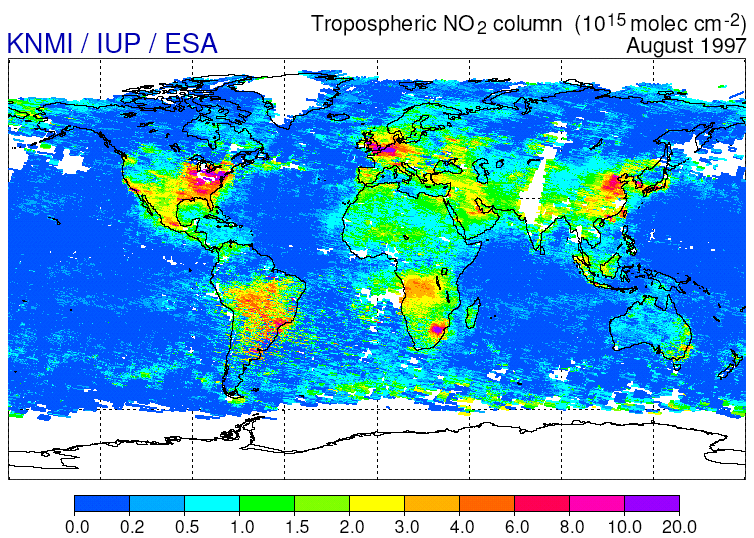
Univ. of Arizona (credits)
Pertanyaan umum yang diajukan adalah mengapa konsentrasi nitrogen dioksida (NO 2 ), sulfur dioksida (SO 2 ) dan karbon monoksida (CO) selalu sangat rendah dan apakah pengukurannya bermanfaat?
Untuk menyoroti pentingnya pemantauan zat-zat ini, artikel ini akan menjelaskan dari mana polutan ini berasal dan bagaimana pengaruhnya terhadap kesehatan kita dan lingkungan.
Singkatnya artikel ini hanya akan fokus pada NO2.
--
Apa itu Nitrogen Dioksida (NO 2 )?
NO 2 adalah gas berwarna coklat kemerahan yang dikeluarkan dari semua mesin pembakaran. Ada dua senyawa utama berbasis nitrogen yang dikeluarkan dari mesin pembakaran: NO 2 dan oksida nitrat (NO). Secara kolektif kedua polutan ini disebut sebagai NO x atau oksida nitrogen.

Untuk meringkas:
- NO2: Nitrogen Dioxyde
- NO: Nitric Dioxyde
- NOx: Oxides of Nitrogen = {NO2+NO}
NO 2 siklus hidup
Pada titik emisi (yaitu pipa knalpot), proporsi NO x adalah sekitar 90% NO dan 10% NO 2 (1).
Setelah beberapa jam berada di atmosfer dan dengan adanya senyawa organik yang mudah menguap (VOC), NO diubah menjadi NO 2 . Reaksi ini dapat terjadi selama beberapa detik hingga beberapa jam (2).
NO 2 bereaksi lebih lanjut dengan zat lain di udara membentuk asam nitrat, partikel dan zat yang disebut PAN (peroksiasil nitrat).
Juga dengan sinar matahari NO 2 dapat diubah kembali menjadi NO dan menghasilkan ozon (O 3 ) sebagai polutan samping. Karena potensi NO 2 untuk menghasilkan polutan "sekunder" ini, maka penting untuk memantau dan mengatur NO 2 .
Bagaimana pengaruh NO 2 terhadap saya?
Paparan NO 2 dalam jangka pendek dan jangka panjang telah dikaitkan dengan peningkatan risiko masalah pernapasan. Penderita asma, anak kecil, dan orang dewasa yang lebih tua memiliki kepekaan yang meningkat terhadap efeknya (1).
Polutan sekunder yang disebabkan oleh adanya NO2 di atmosfer juga mempunyai dampak buruk tersendiri. PAN bersifat iritan, asam nitrat menyebabkan hujan asam dan partikel serta O3 menyebabkan masalah pernapasan.
Siapa dan apa yang mengeluarkan NOx ?
Seperti yang telah disebutkan sebelumnya, emisi NO x berasal dari mesin pembakaran. Namun yang terjadi pada mesin ini adalah reaksi suhu tinggi antara hidrokarbon dalam bahan bakar fosil dengan udara (80% nitrogen). Ada juga sumber emisi NOx alami seperti kebakaran hutan, sambaran petir, namun sebagian besar NO2 di atmosfer disebabkan oleh aktivitas manusia.

Ada banyak industri berbeda yang mengeluarkan NOx . Gambar (2) menunjukkan sumber emisi NOx di AS yang diukur pada tahun 2014. "Sumber bergerak" , yaitu kendaraan jalan raya, kapal, pesawat terbang, kendaraan pertanian, dll, merupakan penyumbang terbesar. Di AS dan Eropa, kendaraan jalan raya merupakan jenis utama 'sumber bergerak' NO x (1) (3).
Di wilayah di mana kendaraan jalan raya merupakan sumber utama NO x, konsentrasi NO 2 sering kali lebih tinggi pada jam sibuk lalu lintas seperti sekitar pukul 17.00 pada hari kerja seperti yang ditunjukkan pada AQI NO 2 di bawah. Beberapa catatan menarik tambahan:
- Konsentrasi ozon (O 3 ) meningkat pada siang hari sedangkan konsentrasi NO 2 menurun. Itu karena NO 2 berubah menjadi NO x dengan adanya sinar matahari.
- Setelah jam 6 sore, konsentrasi NO 2 meningkat karena tidak ada sinar matahari untuk mengubah NO 2 kembali menjadi NO.

Figure 3 Example of AQI in London
Namun di Tiongkok, penelitian yang dilakukan pada tahun 2013 menemukan bahwa sumber industri merupakan penghasil emisi NO x terbesar (34% dari total) (4). Inilah sebabnya mengapa tidak ada hubungan yang kuat dengan konsentrasi NO 2 dan lalu lintas pada jam sibuk.
Mengapa konsentrasi NO 2 sangat rendah?
AQI NO 2 biasanya berada pada kisaran 'Baik' dan ditampilkan dalam warna hijau. Namun karena NO 2 diubah menjadi polutan lain yang mempunyai efek negatif, NO 2 di atmosfer masih berdampak negatif terhadap kesehatan dan lingkungan kita. Jika Anda ingin penjelasan lebih rinci tentang NO x di atmosfer kita, lihat dokumen di bawah ini.
Referensi dan Bacaan Lebih Lanjut
2. Cheremisinoff, Paul N and Young, Richard Alan. Air Pollution Control and Design Handbook. s.l. : M Dekker, 1977. pp. 672-673. Vol. 2.
3. Urban Air Quality in Europe. Boulter, P G, Borken-Kleefeld, J and Ntziachristos, L. [ed.] M Vianna. Berlin Heidelberg : Springer-Verlag, 2013, Handbook of Environmental Chemistry, Vol. 26, pp. 31-54.
4. NOx emissions in China: historical trends and future perspectives. Zhao, B, et al. 13, 2013, Atmospheric Chemistry and Physics, pp. 9869-9897.
